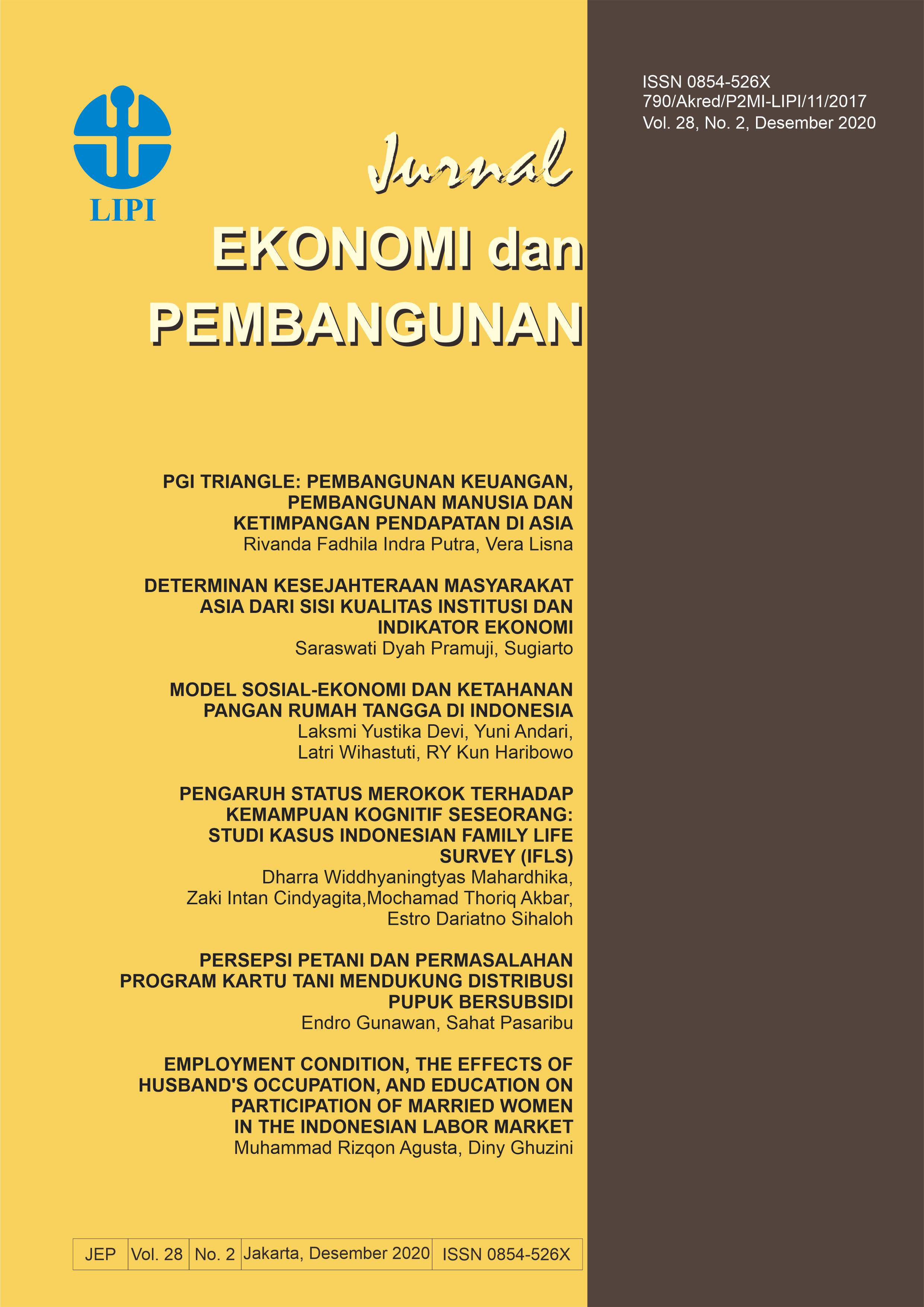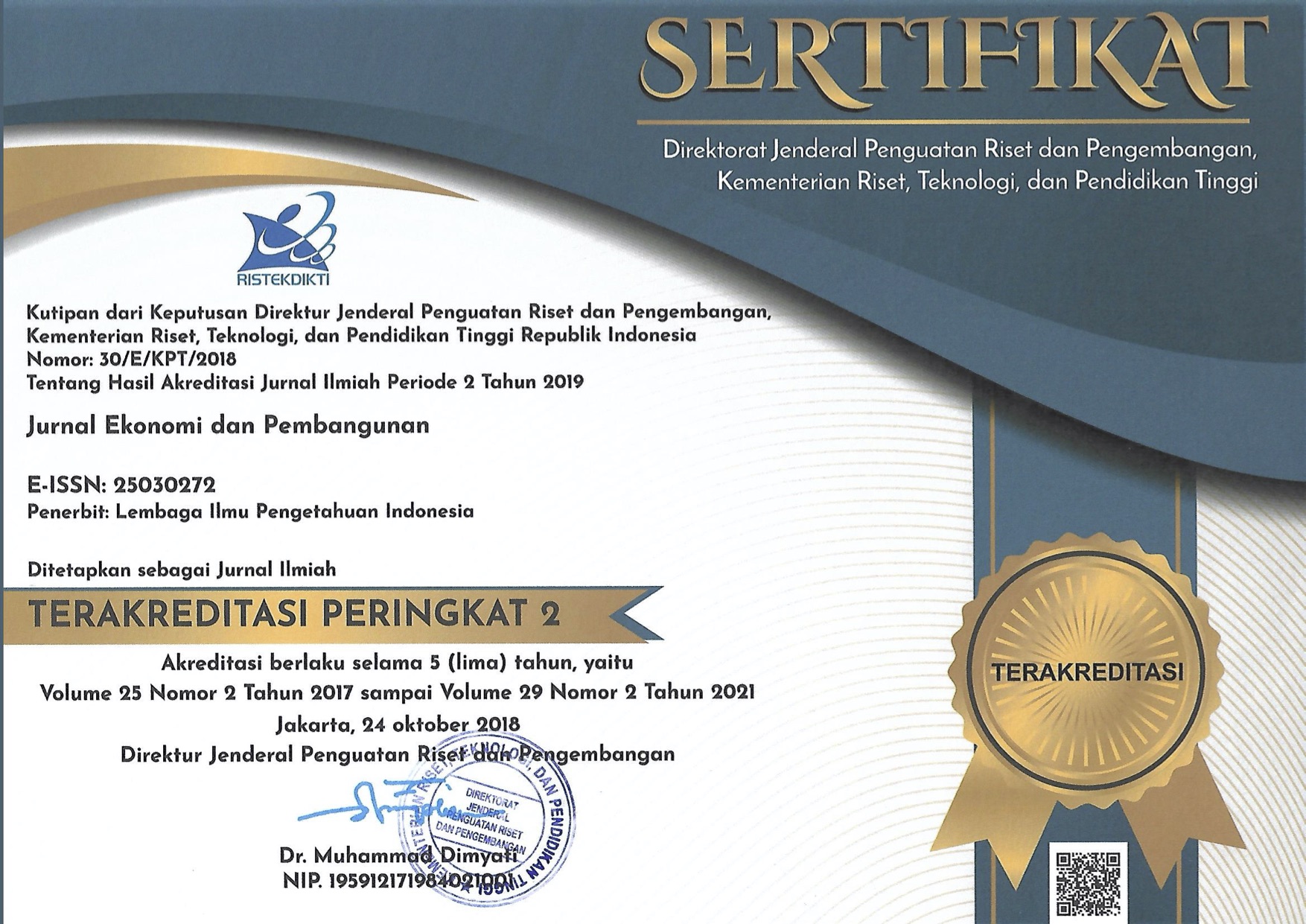PERSEPSI PETANI DAN PERMASALAHAN PROGRAM KARTU TANI MENDUKUNG DISTRIBUSI PUPUK BERSUBSIDI
Abstract
The farmer card program had been launched since 2016 in the java region, but its implementation had not shown significant progress until now. The objective of this study is to analyze the farmers perception of the farmer card program in supporting the distribution of subsidized fertilizers. The results of the analysis using the weighted average index (wai) showed that there were some strong and weak factors of farmers perceptions of this program. The farmers gave a strong factor in their perception about the certainty of obtaining subsidized fertilizers and the ease of obtaining subsidized fertilizer by using the card. However, the farmers also had a strong factor in their perception that the farmer card program wqs not well socialized and had difficulty using the card. On the other hand, the analysis also found that farmers had a weak perception of using farmer cards. This was because the use of farmer cards was not compulsory for the farmer, and there was a lack of promotion from the local kiosk in using the farmer card to obtain fertilizer from local fertilizer distributors. The main problem in implementing farmer card was the lack of awareness from the farmer to use them, difficulties in using the card, and the use of this card was not being required by the local government. To make farmer card program successful, we recommended to implement it as a national program, enhance cooperation and common views among the parties, provide the availability of a communication infrastructure network, and socialize it more comprehensive and planned
Downloads
References
Agustian, A., Hermanto, Kariyasa, I.K., Friyatno, S., Hidayat, D. (2017). Kajian kebijakan subsidi pupuk, harga, distribusi, dan dampaknya terhadap permintaan pupuk dan produksi tanaman pangan. Laporan Hasil Penelitian. Pusat Sosial Ekonomi dan Kebijakan Pertanian, Kementerian Pertanian. Bogor.
Ashari, M.L., Hariani, D. (2019). Analisis efektivitas program kartu tani di Kecamatan Banjarnegara, Kabupaten Banjarnegara. Journal of Public Policy and Management Review, 8 (2), 1-21.
Biro Perencanaan Kemtan. 2019. Evaluasi Kegiatan Strategis Kementan. Bahan Tayang FGD Kartu Tani. Depok
Ditjen PSP. 2019. Mekanisme Penyaluran Pupuk Bersubsidi. Bahan Tayang FGD Kartu Tani. Depok
Ditjen PSP. (2018). Petunjuk pelaksanaan penyediaan dan penyaluran pupuk bersubsidi tahun 2018. Ditjen PSP, Kementan.
Fagi, A.M. (2008). Alternatif teknologi peningkatan produksi beras nasional. Iptek Tanaman Pangan, 3 (1).
Fliegel, E.C., Kivlin, J.E., & Sekhon, G.S. (1971). Message distortion and the diffusion of Innovations in Nothern India. Sociologica Ruralis.
Hanafi, A. (1981). Memasyarakatkan Ide-Ide Baru. Surabaya Press. Surabaya.
Hendayana, R. (2006). Lintasan dan peta jalan (road map) diseminasi teknologi pertanian menuju masyarakat tani progresif. Prosiding Lokakarya Nasional. Akselerasi Diseminasi Inovasi Pertanian Mendukung Pembangunan Berawal dari Desa. Balai Besar Pengkajian dan Pengembangan Teknologi Pertanian.
Hendayana, R. 2014. Persepsi dan adopsi teknologi. Bahan presentasi. Disajikan dalam pelatihan Peningkatan Kapasitas Sumberdaya Peneliti Sosek dalam Analisis Sosial Ekonomi Pertanian. Bogor.
Kurniawati, E., & Kurniawan, A. (2018). Persepsi masyarakat terhadap penggunaan kartu tani di Kabupaten Pati: Kasus di Desa Wotan dan Desa Pakem, Kecamatan Sukolilo. Jurnal Bumi Indonesia, 7(4), 1-15.
Kementerian Pertanian. (2017). Petunjuk pelaksanaan pupuk bersubsidi 2019. Ditjen Saran dan Prasarana Pertanian, Kementerian Pertanian. Jakarta.
Moko, K.W., Suwarto, & Utama, B.W. (2017). Perbedaan persepsi petani terhadap program kartu tani di Kecamatan Kalijambe, Kabupaten Sragen. Journal of Sustainable Agriculture, 32(1), 9-13.
Mufidah, N., & Prabawati, I. (2018). Implementasi program penyaluran pupuk bersubsidi melalui kartu tani di Desa Durung Bedug, Kecamatan Candi, Kabupaten Sidoarjo. Working Paper. Universitas Negeri Surabaya. Surabaya.
Pasaribu, S., & Gunawan, E. (2019). Pelaksanaan aplikasi kartu tani mendukung peningkatan produksi pertanian. Laporan Hasil Penelitian. Biro Perencanaan Kementan dan PSEKP
Rogers, E.M. (1983). Diffusion of innovations. Third Edition, The Free Press, New York.
Sukartawi. (1990). Prinsip dasar komunikasi pertanian. Buku. UI Press. Depok.
Sriwinarti, N.K., & Faesal, A. (2016). Implementasi penggunaan kartu petani sebagai media pengendali distribusi pupuk bersubsidi. Prosiding SENTIA 2016 – Politeknik Negeri Malang Volume 8, ISSN: 2085-2347.
Sukmana, Y. (2017). Apa enaknya punya kartu tani? Kompas.com (diakses 9 Januari 2019).
Sulaiman, A. (2017). Peraturan Menteri Pertanian No.47/Permentan/SR.310/12/2017 tentang Pengadaan dan Penyaluran Pupuk Bersubsidi untuk Sektor Pertanian TA 2018. Kementerian Pertanian. Jakarta.
Waluyo, D. (2017). Kartu Tani: Era baru sejahterakan petani, Jpp.go.id (diakses 10 Mei 2018).
Copyright (c) 2020 Jurnal Ekonomi dan Pembangunan

This work is licensed under a Creative Commons Attribution-NonCommercial-ShareAlike 4.0 International License.
Terms and Conditions of Publication
1. Author's Rights and Authorities
As an author, you (or your employer or institution) may do the following:
-
make copies (print or electronic) of the article for your own personal use (not for commercial purpose), including for your own classroom teaching use;
-
make copies and distribute such copies (including through email) of the article to research colleagues, but not allowed to distribute commercially and systematically, e.g. via an email list or list server;
-
present the article at a meeting or conference and to distribute copies of the article to the delegates attending such meeting;
-
retain all proprietary rights in any process, procedure, or article of manufacture described in the work;
-
include the article in full or in part in a thesis or dissertation;
-
use the article or any part thereof in a printed compilation of your works, such as collected writings or lecture notes, and other derivative works, with full acknowledgement to JEP as the original journal publishing the article;
-
may reproduce material extracted from the article or derivative works for the author's personal use, but must consider the copyrights procedure.
All copies, print or electronic, or other use of the paper or article must include the appropriate bibliographic citation for the article’s publication in the journal.
2. Requests from Third Parties
Although authors are permitted to re-use all or portions of the article in other works, this does not include granting third-party requests for reprinting, republishing, or other types of re-use. Requests for all uses not included above, including the authorization of third parties to reproduce or otherwise use all or part of the article (including figures and tables), should be referred to P2E-LIPI by going to our website at http://ekonomi.lipi.go.id/.
3. P2E LIPI Copyright Ownership
Economic Research Center, the Indonesian Institute of Sciences (P2E-LIPI) owns the copyrights to reproduce, distribute, disseminate, translate, and other uses in accordance with the existing Laws and Regulations.
Every accepted manuscript should be accompanied by "Copyright Transfer Agreement" prior to the article publication.

This work is licensed under a Creative Commons Attribution-NonCommercial 4.0 International License.
JEP Journal by P2E-LIPI is licensed under a Creative Commons Attribution-NonCommercial-ShareAlike 4.0 International License. Permissions beyond the scope of this license may be available at http://jurnalekonomi.lipi.go.id/index.php/JEP
If you are a nonprofit or charitable organization, your use of an NC-licensed work could still run afoul of the NC restriction, and if you are a for-profit entity, your use of an NC-licensed work does not necessarily mean you have violated the term.






